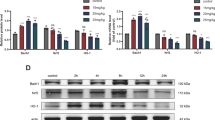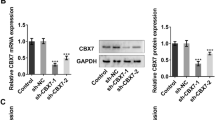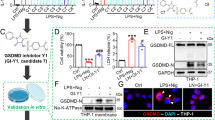Abstract
The cardioprotective property of hydrogen sulfide (H2S) is recently reported. However, cellular signaling cascades mediated by H2S are largely unclear. This study was undertaken to explore the molecular mechanism of H2S-induced cardioprotection in mouse heart by utilizing in vivo model of cardiac injury. We report here that intraperitoneal administration of sodium hydrogen sulfide (NaHS, 50 μmol kg−1 day−1 for 2 days), a H2S donor, significantly (P ≤ 0.05) increased nitric oxide levels in serum as well as myocardium without any sign of myocardial injury. Typical characteristics of myocardial injury induced by isoproterenol (ISO) administration was significantly (P ≤ 0.05) abrogated by NaHS administration as evidenced from reduction in elevated thiobarbituric acid reactive substances (TBARS) and normalization of glutathione (GSH), glutathione peroxidase, superoxide dismutase (SOD), and catalase activity. Further, decrease in TNF-α expression and improvement in myocardial architecture was also observed. However, co-administration of N-nitro-l-arginine methyl ester, a nitric oxide synthase (NOS) inhibitor, and Celecoxib, a selective cyclooxygenase-2 (COX-2) inhibitor along with NaHS and ISO abrogated the beneficial effect of H2S differentially. Inhibition of NOS significantly (P ≤ 0.05) increased serum creatine kinase, lactate dehydrogenase, serum glutamic oxaloacetic transaminase activity and myocardial TBARS, along with significant (P ≤ 0.05) reduction of myocardial GSH, SOD, and catalase. This was followed by increase in TNF-α expression and histopathological changes. Our results revealed that H2S provides myocardial protection through interaction with NOS and COX-2 pathway and inhibition of NOS completely abrogates the hydrogen sulfide-induced cardioprotection in mice.




Similar content being viewed by others
References
Li L, Moore PK (2008) Putative biological roles of hydrogen sulfide in health and disease: a breath of not so fresh air? Trends Pharmacol Sci 29:84–90
Hui Y, Junbao D, Chaoshu T (2004) The possible role of hydrogen sulfide on the pathogenesis of spontaneous hypertention in rats. Biochem Biophys Res Commun 313:22–27
Geng B, Yang J, Qi Y, Zhao J, Pang Y, Du J, Tang C (2004) H2S generated by heart in rat and it’s effects on cardiac function. Biochem Biophys Res Commun 313:362–368
Li L, Bhatia M, Moore PK (2006) Hydrogen sulphide—a novel mediator of inflammation? Curr Opin Pharmacol 6:125–129
Bian JS, Yong QC, Pan TT, Feng ZN, Ali MY, Zhou S, Moore PK (2006) Role of hydrogen sulfide in the cardioprotection caused by ischemic preconditioning in the rat heart and cardiac myocytes. J Pharmacol Exp Ther 316:670–678
Pan TT, Feng ZN, Lee SW, Moore PK, Bian JS (2006) Endogenous hydrogensulfide contributes to the cardioprotection by metabolic inhibition preconditioning in the rat ventricular myocytes. J Mol Cell Cardiol 40(1):119–130
Johansen D, Ytrehus K, Baxter GF (2006) Exogenous hydrogen sulfide (H2S) protects against regional myocardial ischemia-reperfusion injury—evidence for a role of K ATP channels. Basic Res Cardiol 101(1):53–60
Elrod JW, Calvert JW, Morrison J, Doeller JE, Kraus DW, Tao L, Jiao X, Scalia R, Kiss L, Szabo C, Kimura H, Chow CW, Lefer DJ (2007) Hydrogen sulfide attenuates myocardial ischemia-reperfusion injury by preservation of mitochondrial function. Proc Natl Acad Sci 104(39):15560–15565
Minamishima S, Bougaki M, Sips PY, Yu JD, Minamishima YA, Elrod JW, Lefer DJ, Bloch KD, Ichinose F (2009) Hydrogen sulfide improves survival after cardiac arrest and cardiopulmonary resuscitation via a nitric oxide synthase 3-dependent mechanism in mice. Circulation 120(10):888–896
Hu L, Pan T, Neo KL, Yong QC, Bian J (2008) Cyclooxygenase-2 mediates the delayed cardioprotection induced by hydrogen sulfide preconditioning in isolated rat cardiomyocytes. Eur J Physiol 455:971–978
Bolli R (2000) The late phase of preconditioning. Circ Res 87(11):972–983
Sato H, Bolli R, Rokosh GD, Bi Q, Dai S, Shirk G, Tang XL (2007) The cardioprotection of the late phase of ischemic preconditioning is enhanced by postconditioning via a COX-2 mediated mechanism in conscious rats. Am J Physiol 293(4):H2557–H2564
Pacher P, Liaudet L, Bai P, Mabley JG, Kaminski PM, Virag L, Deb A, Szabo E, Ungvari Z, Wolin MS (2003) Potent metalloporphyrin peroxynitrite decomposition catalyst protects against the development of doxorubicin induced cardiac dysfunction. Circulation 107(6):896–904
Chattopadhyay A, Biswas S, Bandyopadhyay D, Sarkar C, Datta AG (2003) Effect of isoproterenol on lipid peroxidation and antioxidant enzymes of myocardial tissue of mice and protection by quinidine. Mol Cell Biochem 245:43–49
Annadora J, Michel B (1995) Oxygen free radicals in rat limbic structures after kainite induced seizurs. Free Radic Biol Med 18:993–1002
Abd El-Gawad HM, El-Sawalhi (2004) Nitric oxide and oxidative stress in brain and heart of normal rats treated with doxorubicine: role of aminoguanidine. J Biochem Mol Toxicol 18(2):69–77
Cai WJ, Wang MJ, Moore PK, Jin HM, Yao T, Zhu YC (2007) The novel proangiogenic effect of hydrogen sulfide is dependent on Akt phosphorylation. Cardiovas Res 26(1):29–40
Ohkawa H, Ohishi N, Yagi K (1979) Assay for lipid peroxides in animal tissues by thiobarbituric acid reaction. Anal Biochem 95:351–358
Zhao G, Al-Mehdi AB, Fisher AB (1997) Anoxia-reoxygenation versus ischemia in isolated rat lungs. Am J Physiol Lung Cellular Mol Physiol 273(6 pt 1):1112–1117
Aebi H (1984) Catalase in vitro. Method Enzymol 105:121–126
Ellman GL (1959) Tissue sulfhydryl groups biophysics. Arch Biochem 82:70–77
Wendel A (1981) Glutathione peroxidase. Method Enzymol 77:325–333
Lowry OH, Rosebrough NJ, Farr AL, Randall RJ (1951) Protein measurement with Folin phenol reagent. J Biol Chem 193:265–275
Banerjee SK, McGaffin KR, Pastor-Soler NM, Ahmad F (2009) SGLT-1 is a novel cardiac glucose transporter that is perturbed in disease states. Cardiovas Res 84:111–118
Mukherjee S, Chen LY, Papadimos TJ, Huang S, Zuraw BL, Pan ZK (2009) Lipopolysaccharide-driven through cytokine production in macrophages is regulated by both Myd88 and TRAM. J Biol Chem 284:29391–29398
Cardounel AJ, Julian D, Predmore BL (2011) Hydrogen sulfide increases nitric oxide production from endothelial cells by an Akt-dependent mechanism. Front Oxidant Physiol (in press). http://www.frontiersin.org/oxidant_physiology/abstract/9722
Karthick M, Prince SM (2006) Preventive effect of rutin, a bioflavonoid on lipid peroxides and antioxidants in isoproterenol induced myocardial infarction in rats. J Pharm Pharmacol 58:701–707
Warenycia MW, Goodwin LR, Benishin CG, Reiffenstein RJ, Francom DM, Taylor JD, Dieken FP (1989) Acute hydrogen sulfide poisoning: demonstration of elective uptake of sulfide by the brainstem by measurement of brain sulphide levels. Biochem Pharmacol 38:973–981
Collins P, Billings CG, Barer GR, Daly JJ, Jolly A (1975) Quantitation of isoprenaline-induced changes in the ventricular myocardium. Cardiovasc Res 9:797–806
Sivarajah A, Collino M, Yasin M, Benetti E, Gallicchio M, Mazzon E, Cuzzocrea S, Fantozzi R, Thiemermann C (2009) Anti-apoptotic and anti-inflammatory effects of hydrogen sulfide in a rat model of regional myocardial I/R. Shock 31(3):267–274
Martin M, Meyer-Kirchrath J, Kaber G, Jacoby C, Flogel U, Schrader J, Ruther U, Schror K, Hohlfeld T (2005) Cardiospecific overexpression of the prostaglandin EP3 receptor attenuates ischemia-induced myocardial injury. Circulation 112(3):400–406
Smalling RW, Feld S, Ramanna N, Amirian J, Felli P, Vaughn WK, Swenson C, Janoff A (1995) Infarct salvage with liposomal prostaglandin E1 administered by intravenous bolus immediately before reperfusion in a canine infarction reperfusion model. Circulation 92(4):935–943
Suchalatha S, Shyamala D (2004) Protective effect of Terminalia chebula against experimental myocardial injury induced by isoproterenol. Indian J Exp Biol 42:174–178
Dhalla AK, Hill MF, Singal PK (1996) Role of oxidative stress in transition of hypertrophy to heart failure. J Am Coll Cardiol 28:506–514
Ji LL, Stratman FW, Lardy HA (1988) Antioxidant enzyme systems in rat liver and skeletal muscle Influences of selenium deficiency, chronic training, and acute exercise. Arch Biochem Biophys 263:150–160
Padmanabhan M, Mainzen Prince PS (2007) S-allylcysteine ameliorates isoproterenol-induced cardiac toxicity in rats by stabilizing cardiac mitochondrial and lysosomal enzymes. Life Sci 80:972–978
Geng B, Chang L, Pan C, Qi Y, Zhao J, Pang Y, Du J, Tang C (2004) Endogenous hydrogen sulfide regulation of myocardial injury induced by isoproterenol. Biochem Biophy Res Commun 318:756–763
Hausenloy DJ, Tsang A, Mocanu MM, Yellon DM (2005) Ischemic preconditioning protects by activating prosurvival kinases at reperfusion. Am J Physiol Heart Circ Physiol 288(2):H971–H976
Dimmeler S, Fleming I, Fisslthaler B, Hermann C, Busse R, Zeiher AM (1999) Activation of nitric oxide synthase in endothelial cells by Akt-dependent phosphorylation. Nature 399:601–605
Marie EG, Veronique G (2004) Regulation of COX-2 protein expression by Akt in endometrial cancer cells is mediated through NF-kappaB/IkappaB pathway. Mol Cancer 3:298–304
Acknowledgments
Financial support was provided by Ramalingaswami Fellowship fund (SKB) from Department of Biotechnology (DBT), Senior Research Fellowship (AK) from Council of Scientific and Industrial Research (CSIR), Government of India and IICT institute fund. We wish to thank Dr J S Yadav, Director, IICT, Hyderabad for providing all kind of support for this study and gratefully acknowledge Dr Rajkumar Banerjee for his suggestions and critical review of the manuscript.
Author information
Authors and Affiliations
Corresponding author
Additional information
Bhavesh Sojitra and Yogesh Bulani contributed equally to this study.
Rights and permissions
About this article
Cite this article
Sojitra, B., Bulani, Y., Putcha, U.K. et al. Nitric oxide synthase inhibition abrogates hydrogen sulfide-induced cardioprotection in mice. Mol Cell Biochem 360, 61–69 (2012). https://doi.org/10.1007/s11010-011-1044-6
Received:
Accepted:
Published:
Issue Date:
DOI: https://doi.org/10.1007/s11010-011-1044-6




